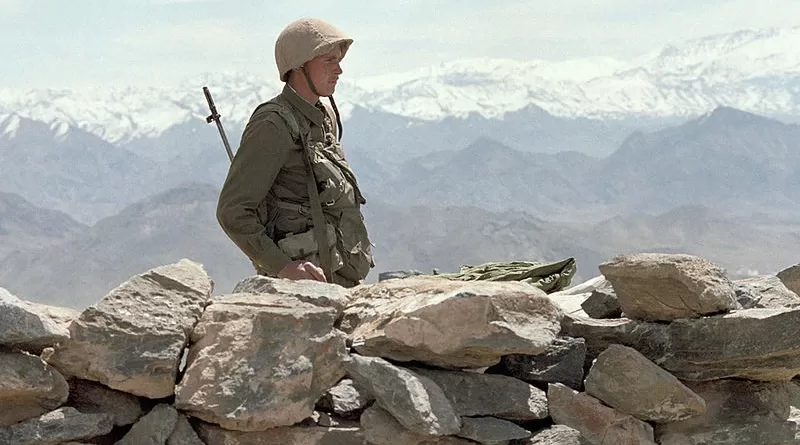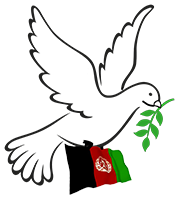By Advocate Mazhar Siddique Khan
Eurasia Review
April 15, 2025
Afghanistan is often called the “graveyard of empires”—a romantic label used to suggest that no foreign power can conquer it, that the country has single-handedly humbled giants like Afghanistan is often called the “graveyard of empires”—a romantic label used to suggest that no foreign the Soviet Union and the United States. It’s a phrase etched into the rhetoric of resistance and frequently deployed to invoke Afghan valor and perseverance. But behind the slogan lies a dangerously simplified version of history—one that clouds the past and impedes a realistic understanding of Afghanistan’s present and future.
The idea that Afghanistan defeated two superpowers alone is a myth, and one that does more harm than good.

A Russian soldier-internationalist guards roads during the Soviet-Afghan War. Photo Credit: RIA Novosti, Wikipedia Commons.
Behind the Soviet Retreat: A Cold War Coalition
When Soviet troops withdrew in 1989, it was certainly a landmark moment in Afghan history. But it was not the result of isolated, indigenous resistance. The Mujahideen were backed by a coalition of countries with converging geopolitical interests—chiefly the United States, Pakistan, Saudi Arabia, and China.
Operation Cyclone, the CIA’s covert effort to fund and arm the anti-Soviet insurgency, was one of the most expensive covert operations in U.S. history. Billions of dollars in weapons and intelligence flowed into the country through Pakistan’s Inter-Services Intelligence (ISI), which served both as facilitator and gatekeeper. Saudi Arabia matched U.S. funding dollar-for-dollar and provided ideological backing. China, too, saw the opportunity to undermine Moscow through indirect involvement.
What unfolded in Afghanistan was not a lone insurgency, but a classic proxy war—one shaped, sustained, and ultimately resolved not by local fighters alone, but by the calculations of distant capitals.
The U.S. Withdrawal: Exit by Design, Not Defeat
The images of Taliban fighters entering Kabul in August 2021 gave fresh life to the “graveyard” narrative. But once again, the surface optics obscure the deeper truth.
The United States did not leave Afghanistan because it was militarily defeated. By 2020, U.S. combat deaths were in the single digits annually. The decision to withdraw was a political one, rooted in a sense of strategic fatigue and shifting global priorities. Successive administrations, starting with President Obama and continuing through Trump and Biden, grappled with an enduring question: What was America still doing in Afghanistan, and at what cost?
Washington’s exit was not precipitated by Taliban military dominance, but by a growing belief that a military solution was neither feasible nor affordable. The collapse of the Afghan Republic came not from a final Taliban offensive alone, but from within—a failure of political cohesion, institutional rot, and loss of public confidence.
Collapse from Within
This pattern isn’t new. The People’s Democratic Party of Afghanistan (PDPA), the Soviet-backed regime, didn’t fall immediately when Soviet troops left. It held on until 1992, when the USSR’s collapse ended the flow of support and internal fissures became unmanageable. Similarly, the Western-backed Republic of Afghanistan had years of international support but was undone by factionalism, corruption, and elite disconnect from the broader population.
The fall of these regimes says more about internal fragility than about the strength of those who opposed them.
External Hands in Every Era
From the 19th century Anglo-Afghan Wars to the 21st-century global war on terror, foreign involvement in Afghan conflicts has been constant. During the British invasions of 1839, 1878, and 1919, Afghan rulers capitalized on great power rivalries, sought arms from competing empires, and engaged in complex diplomacy. Even Afghanistan’s eventual assertion of independence in 1919 came as Britain reeled from the exhaustion of World War I.
Afghan resistance has always been shaped by its ability to attract and exploit external support. Heroism alone didn’t win wars—strategy, geography, and foreign alliances did.
Mythmaking and Its Consequences
The mythology of Afghanistan defeating empires may offer a moment of national pride, but it comes at a cost. It obscures the enormous toll exacted on the country itself: millions dead or displaced, generations born into war, cities and institutions reduced to rubble. It feeds a self-image of righteous resistance while ignoring the hard truths of dependence, fragmentation, and lost opportunities.
More importantly, it undermines honest dialogue about what went wrong—and what comes next. A nation that believes it never needed help may not recognize when it needs cooperation. A people told they always win may not prepare for the hard work of building stable institutions and peaceful coexistence.
The future of Afghanistan does not lie in repeating myths, but in confronting realities: that no victory was ever achieved alone, and that no lasting peace can be forged without sober reflection and regional collaboration.
 Afghanistan Peace Campaign
Afghanistan Peace Campaign